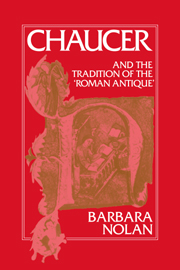Book contents
- Frontmatter
- Contents
- Acknowledgments
- List of abbreviations
- Introduction
- 1 Benoît de Sainte-Maure's Roman de Troie and the compositional practices of the roman antique
- 2 Plaits, debates, and judgments in the Roman de Thèbes, the Roman de Troie and the Roman d'Eneas
- 3 The poetics of fine amor in the French romans antiques
- 4 From history into fiction: Boccaccio's Filostrato and the question of foolish love
- 5 Boccaccio's Teseida and the triumph of Aristotelian virtue
- 6 Saving the poetry: authors, translators, texts, and readers in Chaucer's Book of Troilus and Criseyde
- 7 The consolation of Stoic virtue: Chaucer's Knight's Tale and the tradition of the roman antique
- Epilogue
- Notes
- Bibliography
- Index
6 - Saving the poetry: authors, translators, texts, and readers in Chaucer's Book of Troilus and Criseyde
Published online by Cambridge University Press: 11 September 2009
- Frontmatter
- Contents
- Acknowledgments
- List of abbreviations
- Introduction
- 1 Benoît de Sainte-Maure's Roman de Troie and the compositional practices of the roman antique
- 2 Plaits, debates, and judgments in the Roman de Thèbes, the Roman de Troie and the Roman d'Eneas
- 3 The poetics of fine amor in the French romans antiques
- 4 From history into fiction: Boccaccio's Filostrato and the question of foolish love
- 5 Boccaccio's Teseida and the triumph of Aristotelian virtue
- 6 Saving the poetry: authors, translators, texts, and readers in Chaucer's Book of Troilus and Criseyde
- 7 The consolation of Stoic virtue: Chaucer's Knight's Tale and the tradition of the roman antique
- Epilogue
- Notes
- Bibliography
- Index
Summary
With his usual fastidious attention to “effects,” Chaucer's Pandarus, ever guiding his young protégé towards pleasure, tells Troilus how to write his first love letter. “Hold,” he says, “of thi matere/ The forme alwey, and do that it be lik” (ii. 1039–40). These instructions, adapted from Horace's Art of Poetry, do not appear in Boccaccio's Filostrato. Through them Chaucer deepens Pandarus' characterization as a craftsman, shaping his materials by his dazzling manipulations of trouth, sooth, and aventure. In the event, Troilus manages to follow his master's advice exactly. He produces an epistle filled with sentimental commonplaces – “thise … termes alle/ That in swich cas thise loveres alle seche” (ii. 1067–68). In his modus tractandi, moreover, the young lover follows precisely the medieval “forme” prescribed for such epistles. Beginning with an elaborate salutation, he moves to a petition, adds a narratio, and concludes with a promise of endless fidelity. Nor is Troilus' love letter the only example, in Chaucer's masterpiece, of a literary form perfectly calibrated to “hold” its matere. The lover's several complaints and formal lyrics (including a Petrarchan sonnet translated into rhyme royal), Antigone's love song in Book ii, Calkas' oration in Book iv, all conform to rules prescribed by tradition and theory.
When we ask, however, what large “forme” Chaucer himself chose to contain the ancient, tragic matter of Troy as he composed his medieval Book of Troilus and Criseyde, no simple answer presents itself.
- Type
- Chapter
- Information
- Chaucer and the Tradition of the Roman Antique , pp. 198 - 246Publisher: Cambridge University PressPrint publication year: 1992

